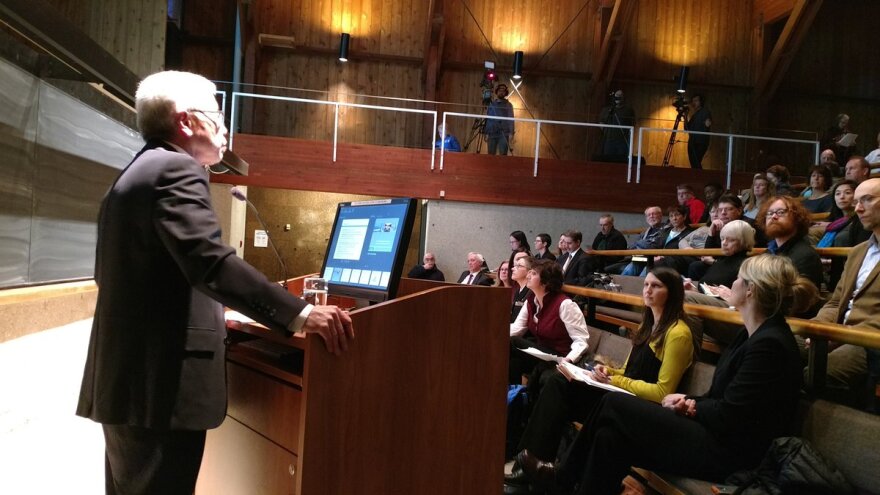About one year ago, state health and environmental officials were alerted to and tasked with dealing with the discovery of the chemical PFOA in drinking water supplies in Southern Vermont. WAMC’s Southern Adirondack Bureau Chief Lucas Willard traveled to Bennington last night where the state’s health official revealed results of blood testing conducted over the last year.
Vermont State Health Commissioner Dr. Harry Chen spoke in a lecture hall at Bennington College Thursday evening. He discussed the blood-testing results of 472 Bennington-area residents who were exposed to the industrial chemical PFOA.
It’s the same chemical found in water supplies in nearby Hoosick Falls and Petersburgh, New York. In the Bennington area, it has been linked to the former Chemfab Plant, now owned by company Saint-Gobain.
The chemical itself has been tied to ill-health effects including kidney and testicular cancer.
But Dr. Chen cautioned that the science is still out on how much PFOA in a body will cause what, if any, problems.
“Clearly the uncertainty is there, that we can’t equate a PFOA level with any known or predicted health effects,” said Chen.
In the Bennington area, the average blood concentration of PFOA in those tested was 10.1 micrograms per liter. Just over the New York border in Hoosick Falls, the average is 23.5. Some had concentrations several times higher. The national average is 2 to 6 micrograms per liter.
Higher concentrations were found in people who worked with the chemical at the Chemfab site and those with private wells. Lower concentrations were found in those who lived with municipal water, which is PFOA-free.
Common health effects among affected residents associated with larger studies included high blood pressure and cholesterol.
Chen said the key points of the study are: the determination that PFOA in your blood comes from PFOA in your water, that the blood test can’t tell you if a health effect was caused by PFOA, and that levels will decrease by half every three to four years.
Dr. Alan Woolf, a pediatrician and medical toxicologist with Boston Children’s Hospital and Harvard Medical School, cautioned people to “mind the gap” between what was found locally and what’s been found in studies with humans and other mammals. He urged residents to understand that although the health effects are associated with PFOA, that alone doesn’t prove causation.
The health effects of many so-called PFAS chemicals are unstudied.
The seemingly simple conclusions and advice puzzled several in the audience who had been exposed to PFOA. One resident questioned Dr. Woolf about her own symptoms.
“My levels are very high. And to look at me, I’m a healthy individual. I’ve had my problems that may progress and they are related to this…”
“Again,” responded Woolf, ”when you talk about causation, you’re not talking about any of these conditions. So, just to reemphasize that these are associations that have been shown in human studies. But that doesn’t mean that this exposure caused that condition.”
The second half of the meeting was focused on the future and how Vermont’s agencies would find solutions to the water problems under new Republican Governor Phil Scott.
The state is negotiating with the company it has deemed to be the polluter, Saint-Gobain, which owns the former Chemfab plant.
Last year, officials including the former Department of Environmental Conservation Commissioner had said that the state would pursue municipal line extensions in Bennington in 2017 and would seek a $2 million reimbursement from Saint-Gobain for an engineering study.
Former DEC Commissioner Alyssa Schuren spoke last September.
“I’m here to announce the state has decided to pay for that because Saint-Gobain has not committed to that yet,” said Schuren to applause.
The entire project to extend clean water lines to those with polluted wells could cost $35 million.
On Thursday night, some former officials were absent but several faces at the meeting were familiar, and some came down to introduce themselves. Julie Moore is the state’s new Secretary of Agricultural and Natural Resources.
“I want to assure you that there will be no change in approach even though there is a new team in place at least at the top. I say that because we will have the same technical and legal team in place that has been working on this since day one,” said Moore.
Moore said negotiations continue with Saint-Gobain but that the administration was surprised by a letter sent by the company late last year that said carbon filtration systems on homes with contaminated wells is an effective permanent remedy. The company has paid for the installation of filtration systems and the distribution of bottled water.
The letter came as state Senators Brian Campion and Dick Sears introduced a bill to hold Saint-Gobain accountable for the municipal line extensions.
Moore was optimistic the state could reach a settlement with Saint-Gobain and that it would remain a “partner,” but admitted that the negotiations were going slower than hoped for.
“Ultimately the pace of the municipal water line extension will depend on whether Saint-Gobain will be a partner with the state and our goal remains to see construction start in 2017.”
Health Commissioner Chen will be leaving his post in March, but pledged that all data and research would remain and promised a smooth transition.
“The players and the data and the commitment to protecting public health is still going to be there,” said Chen.
Another round of blood testing for Bennington-area residents will be held.







